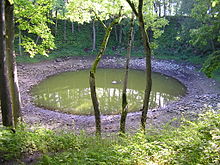Kaali meteorite crater
Coordinates: 58 ° 22 ′ 19 ″ N , 22 ° 40 ′ 10 ″ E
The Kaali meteorite crater is on the Estonian island of Saaremaa located main craters (Kaali Meteoriidikraater) of a meteorite impact about 4,000 years ago. It is located 18 kilometers from Kuressaare in a grove near Kaali . The center of the crater is a greenish pond about 50 meters in diameter, surrounded by a 16-meter-high embankment with a diameter of 110 meters. Eight secondary craters can be found in the vicinity of the impact crater, which are significantly smaller with diameters between 15 and 40 meters.
The impact of the meteorite left its mark in Finnish and Scandinavian lore. He is also said to have been mentioned in his notes by the Greek author Pytheas . There are several myths about the origin of the craters among the population of Saaremaa. The earth is said to have devoured the wedding church here out of horror over a sibling marriage. Another legend tells of a landlord who is said to have been devoured from the ground after an unrestrained orgy, including the manor and party.

In the 18th and 19th centuries, various theories arose about a volcanic eruption , salt pressure, a gas explosion or a prehistoric water reservoir. The interpretation as an impact crater was first suggested by Alfred Wegener , who visited Saaremaa Island in 1927 as part of a series of guest lectures in Riga. Finally, in 1937, the geologist Ivan Reinwald was able to clearly prove the impact of an iron meteorite after discovering charred wood residues and meteorite fragments with a nickel content of 8.3% .
Further research completed the now recognized overall picture. It is assumed that a meteorite originally weighing 400 to 10,000 tons entered the earth's atmosphere from a north-easterly direction at a speed of 15 to 45 km / s, steadily losing mass due to the friction and finally at an altitude of about five to ten kilometers several fragments broke apart. The largest of these fragments hit with a weight of 20 to 80 tons and an impact speed of 10 to 20 km / s and left the said crater. The eight secondary craters caused further smaller fragments.
Web links
See also
Individual evidence
- ↑ Christine Reinke-Kunze: Alfred Wegener, polar researcher and discoverer of the continental drift. Birkhäuser, Basel / Boston / Berlin 1994, ISBN 3-7643-2946-7 , pp. 95-96.
